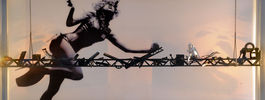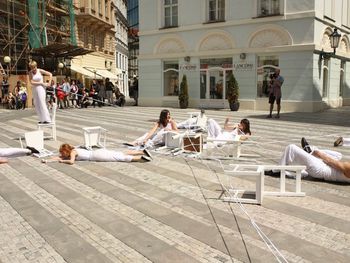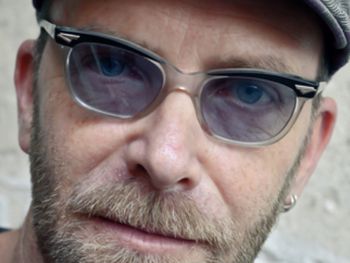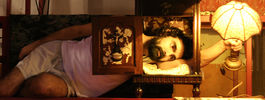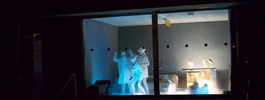Back
1975 » Canada » Stage and costume design
KANADA
Just as theatre and entertainment in general are cultural manifestations
with several facets, Canada is an immense country with many different cultural and social aspects. As a Canadian scenographer I would not be able to discuss the theatre in its entirety or its evolution in a country where distances are so great. This exhibition brings together scenographers and technicians; it is primarily for them, basing myself on my personal experience, that I would like to present a brief picture of recent devolopments in the field of scenography in Canada. I know, however, that many of my colleagues share my views.
I had the privilege of working on the development of a theatre to which one might apply the definition formulated by the French scenographer René Alliot just after World War II "An empty space where one can arrange the stage and the auditorium according to the needs of each production". The design of the Octave-Crémazie Theatre in the Grand Theatre de Quebec was inspired by this definition. What we wanted was a research centre and, not knowing just where that would lead us, we increased the versatility of the furnishing and equipment by opting for a completely manual system of transformation. Almost all drama at that time developed on the assumption that the Italian-style stage would be used; we were obliged to favour that sort of arrangement in the choice and disposition of our equipment.
We have learned, after five years' experience, that the classical formula is seldom used. One of the reasons is that the number of seats available is much greater with other possible configurations. The management applies pressure for the maximum use of available space for budgetary reasons. This experience leads one to suggest to architects and to directors of modem theatre companies that they should build auditoria in which too great versatility would give way to greater efficiency. Mechanization for example, appears to restrict possibilities but, without compromising the versatility of the theatre, it assures greater efficiency in terms of time and labour and thus increased profits.
The increasing number of theatres in Canada and in the world will confirm the evolution of relations between playwrights, directors and stage designers. The era when the creativity of directors was limited by restricted techniques is over.
The scenographer of today has such technical resources at his disposal that, not only can he offer greater scope to the director, but moreover he can inspire the director to explore with him all possible uses of the new architecture.
We shall continue to build classical auditoria because they respond to certain needs, but the versatility and the possibilities of theatres which really are empty spaces, infinitely adaptable, will come increasingly to the fore. Already the new, young theatre companies in Canada are looking for versatile theatres which liberate creativity from almost all constraints. It is up to us to explore the possibilities offered by these facilities and these techniques and to encourage at the same time the creation of new works.
How can one describe in a few words scenography in Canada? One can only call attention to a few tendencies as seen by only one scenographer. And yet, I am a scenographer and I am a Canadian.
Exhibiting artists / ateliers
[show all
| hide all]
- Murray Laufer
Additional information: Murray Laufer is one of Canada's leading designers. After graduating from the Ontario College of Arts, where he received the "Reeve and Son" scholarship for drawning and painting, ne began in a design career at the Crest Theatre.
He designed many of the festival serie and special concerts for C.B.C.television., including presentations with John Sutherland, Louis Quilico, Renata Tebaldi, Carol Ancerl et Seiji Ozawa. His first production for the Canadian Opera Co. was Love for three oranges, Fidelio, Louis Riel, The flying Dutchman, Bluebeard's Castle and Aida area few of the many he designed for the Canadian Opera Co. His work has been represented at both World Expo '67 /Canada/ and World
Expo '70 /Japan/. He has created design for Stratford Avon Theatre and for the Charlettetown Festival. At the St.Lawrence Centre in Toronto, some credits include Puntila, Galileo, Electra, The goodwoman of Se-Tchouan, Article 58 and The Plough and the Stars. A recipient of a Centennial Medal and a Canada Council study-grant, Mr.Laufer was the first designer to be elected to the Royal Canadian Academy.
Obrázky z katalogu
Exhibiting works
-
Bertolt Brecht: (The Good Person of Szechwan),
0
-
: (Electra),
0
-
Ludwig van Beethoven: (Fidelio),
0
-
Harry Somers: (Louis Riel),
0
-
Seán O'Casey: (The Plough and the Stars),
0
-
Richard Wagner: (Twilight of the Gods),
0
-
Béla bartók: (Bluebeard's Castle),
0
-
Nikolai Gogol: (Marriage),
0
-
Bertolt Brecht: (Life of Galileo),
0
- Francois BARBEAU
Additional information: Francois Barbeau was born in Montreal in 1935. After he gratuating from Sir George William College /Fine Arts/, he studied with Cotnoir Capponi /cutting and pattern design/. He began his career in the "Roulotte" for the Montreal City Parks, where he designed the costumes of some productions. He went to Europe on a Canada Council study-grant. After coming back to Montreal, he taught at the National School of Theatre of Canada and was also responsible for their costumes work-shop. He was resident costume-designer at the "Théatre du Rideau Vert". He was also responsible for the creation of a properties and costumes work-shop. In 1971, he became head of the Design department of the National School Theatre of Canada. Over a period of years, Francois Barbeau was associated with most theatre companies in Montreal: some companies for which he worked are the "Théatre du Nouveau-Monde", the "Egrégore", the "Nouvelle Compagnie Théatrale", the "Compagnie Jean Duceppe", the "Théatre de Quat'Sous", etc., and for the
"Théatre du Rideau Vert" he created the costumes for more than 50 productions. He has worked with over thirty directors and he has created the costumes for more than 100 productions. He is also well-known for his works with "Les Grands Ballets Canadiens", the "Boston Ballet, the Harkness Ballet of New York, the Beer-Sheva Ballet of Israel, the Richard Kuch Company, etc. Mr.Barbeau extended his design ability to the cinema where he created the costumes for six films as well as being the art-director for three of them. For his work on "Kamouraeka" and "Elisa Horoscope", he received the Canadian Film Award's prize.
Obrázky z katalogu
Exhibiting works
-
L. Carroll: (Alice's Adventures in Wonderland),
Théatre du Rideau Vert
1971
-
Jean Anouilh: (Becket),
Théatre du Riedau Vert
1971
-
Samuel Beckett: (Waiting for Godot),
Nouvelle Compagnie Théatrale
1971
-
Eugene Ionesco: (Macbeth),
Théatre du Nouveau Monde
1973
-
Carlo Goldoni: (The Chioggia Scuffles),
Théatre du Rideau Vert
1971
- Ronald J. THOM
Additional information: The Thom Partnership. Originally from the west coast, Mr. Thom now practises architecture throughout Canada from his Toronto office. He was won design awards in Canada and the United States and is an active writer and lecturer. Recent projects by his office include the Toronto Zoo and the United World College on Vancouver Island.
Obrázky z katalogu
- Peter SMITH
Additional information: The Thom Partnership. Born in Britain, Mr.Smith has worked in Canada and the United States since 1959. Together with Ronald Thom he was responsible for extensive work at Expo '67 and several major universities and colleges. Since 1973 Mr. Smith has designed several theatre buildings in Canada and is currently completing a 2 theatre complex in London, Ontario.
Obrázky z katalogu


